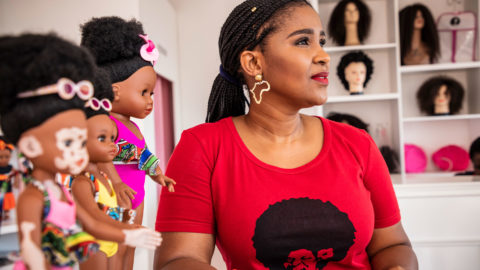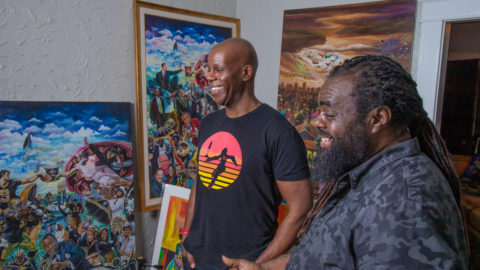Maestro of fun, mastermind of memes: meet the creator of the Microsoft ninja cat
KC Lemson on the merits of making fun of herself and the company she loves
KC Lemson is socially awkward. That’s not my observation; she told me that about herself in an email. “Don’t forget, I’m totally socially awkward so that should totally come across in the story. Because the best way to overcome being socially awkward is to announce it and just own it so that people understand when I’m weird.”
Lemson is the mastermind behind Microsoft’s ninja cat meme—a beloved grassroots movement that unified employees—as well as many other company moments and memorable missives. The day I met with her, she stood hunched over her desk, typing rapidly. “Firing off one last email,” she tossed.
I get the sense that standing at her sit-down desk, racing to tackle just one more thing, is par for Lemson’s course.
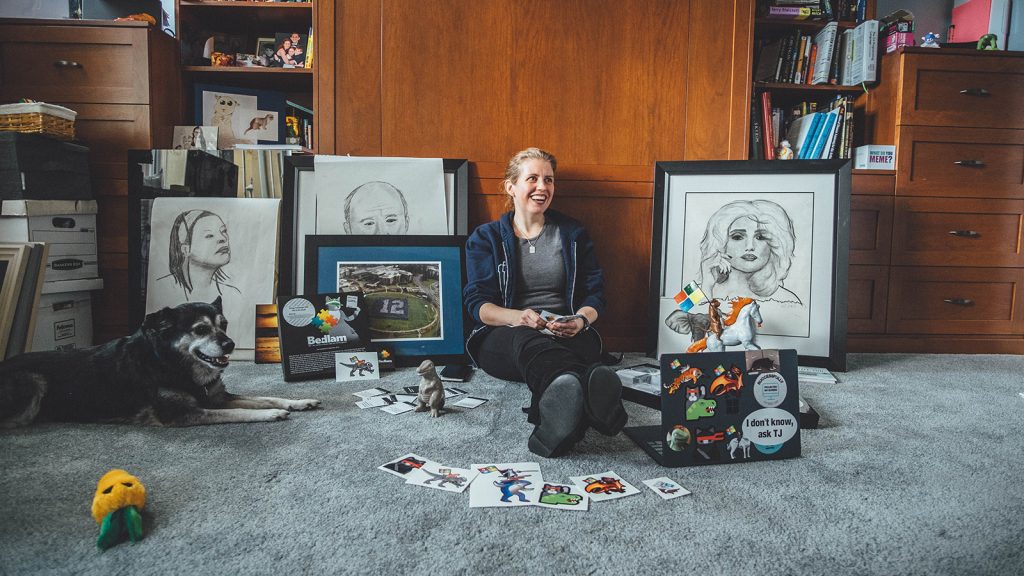
After 19 years and roughly 10 roles at Microsoft, Lemson is a visionary, a kind of social instigator, and a tech artiste—something of a corporate pioneer who blazes her own trail. “More like a bull in a china shop,” she said, laughing.
Lemson started as a tester on the Outlook team and then moved to program management for Microsoft Exchange Server. She later moved over to the mobile division, then operating systems, and now is a senior director of program managers in Surface. She’s crazy busy and yet somehow radiates a steady energy. She’s not frenetic and doesn’t keep busy just for the sake of it.
“I get passionate about whatever it is,” she explained, her face flushed. “I am not obsessive; I’m excitable.”
The making of a ninja cat
It’s apparent that Lemson hates the limelight. Her endearing jitters manifested throughout our interview, with several dropped pens and frequently shifting body postures: legs crossed, legs propped on a box, sitting on legs.
She’s funny, and, frankly, a little hard to keep up with. Puns, internet memes, historical references, tech jargon, and sci-fi references all fly out of her mouth, rapid-fire. It seemed best to just play along and pretend I knew what she was talking about.
“Oh, just let me move that,” she said, grabbing a stuffed animal off a chair in her Redmond office. A gift from a coworker, the toy is more than office decoration: it’s ninja cat, the character Lemson created in 2014. Since then, ninja cat—with its message of playfulness, unity, and pride—has been embraced as an unofficial mascot by many Microsoft employees.
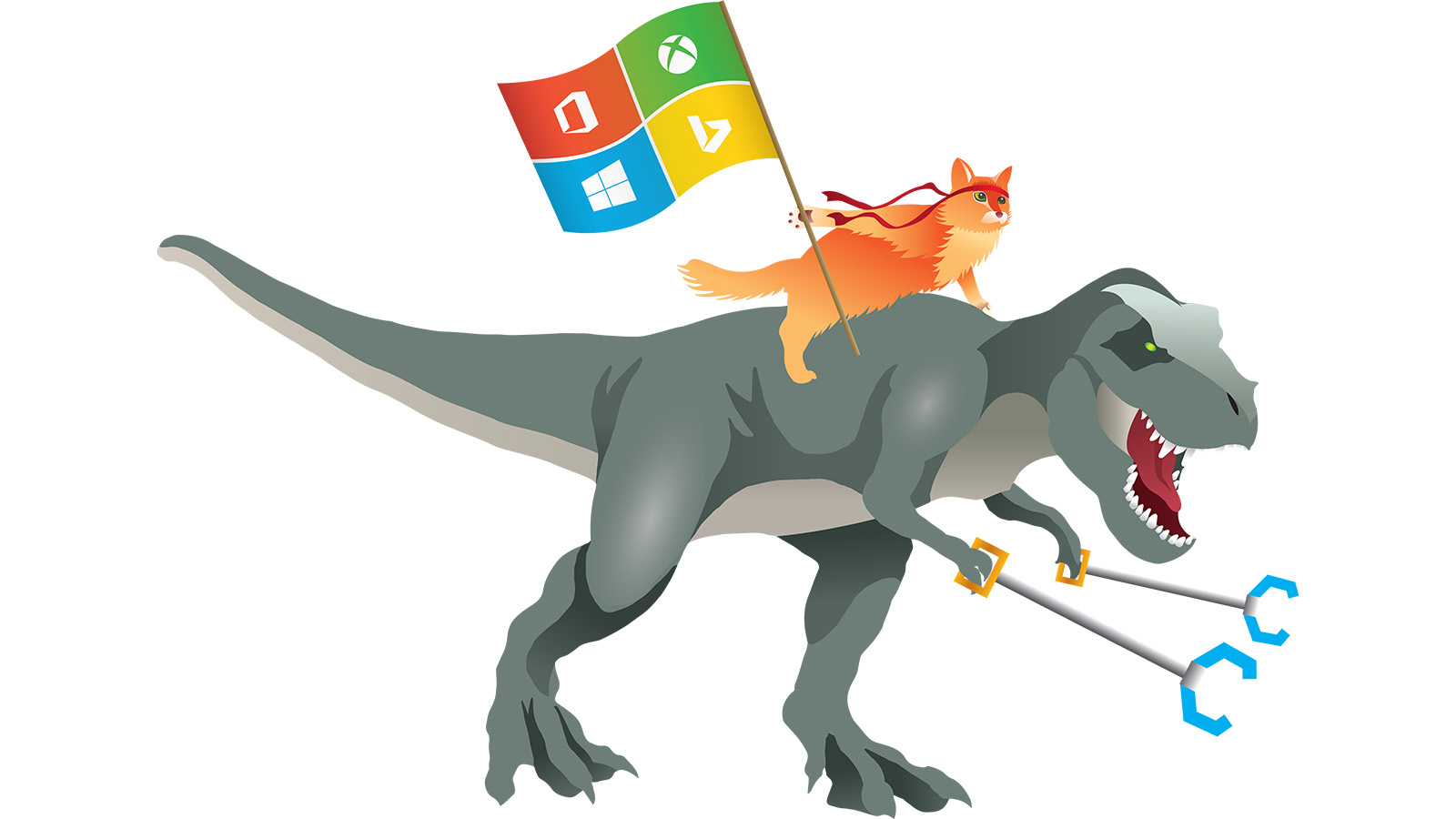
The stuffed ninja cat in Lemson’s office is mounted on a Tyrannosaurus rex, one of the many steeds the character can be found riding on in toy form, on stickers, emblazoned on other gear, and even in desktop themes for Windows.
The original ninja cat rode a unicorn, but Lemson explained why the T. rex is her favorite of all the steeds.
“If you are depressed, just imagine a T. rex making a bed,” she said. “You’ve seen that meme, right?” (I hadn’t.)
But if you put grabby arms on a T. rex, “it effectively becomes unstoppable,” Lemson said.
The whole ninja cat buzz was kind of accidental, Lemson explained in a blog post. Drawing inspiration from the viral Welcome to the Internet meme by Jason Heuser, Lemson created a graphic for a PowerPoint presentation that showed the cat (which Lemson says is a female) on a unicorn holding a flag adorned with the Microsoft logo.
It was “a visual that spoke to a sort of zeitgeist about where we were headed,” she wrote. Ninja cat helped spread the message that Microsoft was united and committed to collaboration.
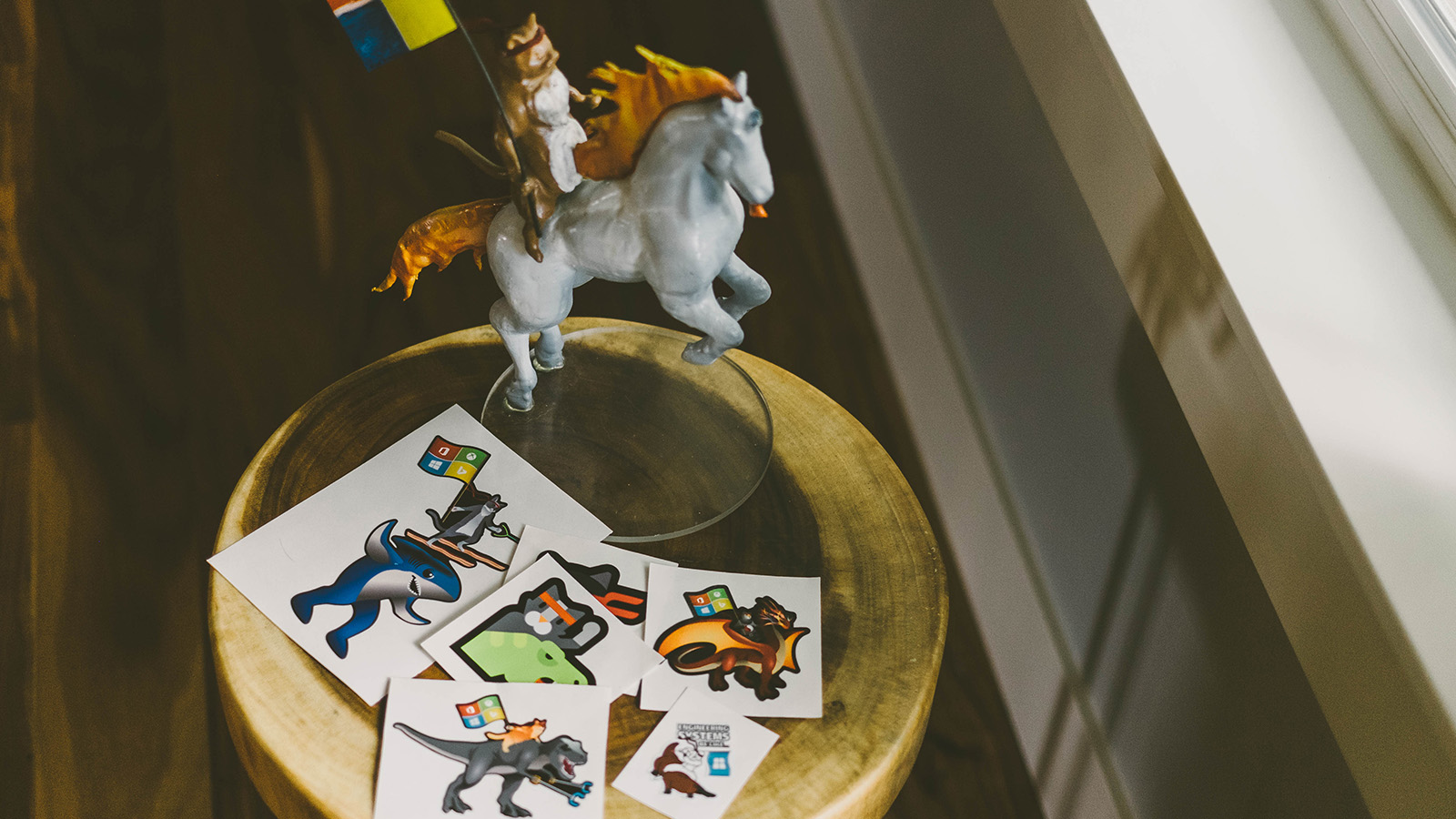
That PowerPoint slide morphed into requests for T-shirts, which morphed into stickers on laptops, which sparked a fire with employees. Soon, the symbol became shorthand for the company’s culture change and was popping up everywhere. Even CEO Satya Nadella has been spotted in his ninja cat T-shirt.
Now, it seems like employees don’t wonder about its origin story. Ninja cat just is.
“I first saw the ninja cat on screen at an engineering conference and, like everyone else, loved it,” said Frank Shaw, Microsoft’s corporate vice president for communications. “One of the topics at the time was how the engineering teams had to work better together and break down silos. A few days later, a ninja cat T-shirt showed up on my desk. That creativity and speed and willingness to have fun—that’s a piece of our culture worth building on.”
Lemson’s superpower is a sixth sense for finding zeitgeist moments at Microsoft, time and time again, somehow without even trying. Her antics and adventures have helped rouse employee spirit and cultivate social media intrigue. Even so, she’s less interested in being on trend than she is in having a “helluva lot of fun.”
Fun, with something to show for it
Even the maestro of fun has a hard time keeping up with all the cool things she’s done. Never fear, she can check her ongoing list, saved in her OneDrive under “All the fun things I’ve done.”
There’s squeaky lobster, MAPI makes me HAPI T-shirts, and social media blasts asking “What would Dracula’s Windows Phone look like?” She even designed some of the swag for Windows Phone store and Exchange (a result of what she calls knowing “just enough Photoshop to be dangerous”).
She also helped organize 7,000 Microsoft employees into the shape of the number 12 as an ode to the Seattle Seahawks football team—an event that was covered by GeekWire. Lemson orchestrated the time-lapse video of the whole ordeal.
Then there’s Bedlam, the card game Lemson made that was inspired both by the dark-humored Cards Against Humanity game and also a Tumblr site Lemson follows called Ladies Against Humanity, a site that seeks to fight misogyny through irreverent humor. (Confession: many hours were consumed in the writing of this story between that Tumblr site and Lemson’s Twitter account.) It all started when Lemson and her teammates joked that it would be funny to do a Microsoft version of Cards Against Humanity.
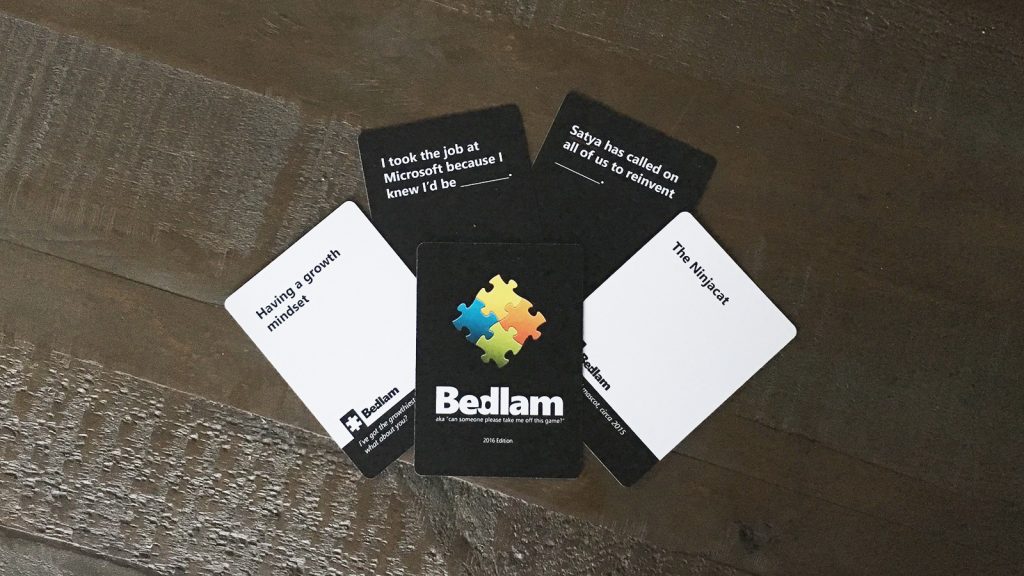
Whereas most folks have an idea and usually just leave it at that, Lemson obsesses about following through. She doesn’t just want to do something fun with no purpose. To hook her, there’s got to be a product, something to show at the end.
Lemson got some wine and a few coworkers—one of whom is her husband, David—together, and they came up with the cards. Later, Lemson spent hours testing to see if the game was playable. It was. The questions hinge on inside jokes, company trivia, and corporate lore.
Questions like “Satya has called on all of us to reinvent _____” can be combined with silly answers like “meetings where the first 10 minutes are spent getting the projector to work.” One card says, “True culture change starts with _____.” Its potential answer: “being the first one to start a ‘reply all’ storm.” Another detail Lemson loves: Satya’s name shows up on the cards with a red squiggly line underneath—to indicate misspelling.
Employees can buy their own copies of the Bedlam game at the internal Microsoft company store, and close to 700 copies have been sold. Lemson also used the game to raise money through the company’s employee giving program—with Microsoft employee matching, she raised close to $40,000 for charity.
“Making fun of ourselves, it’s just literally fun,” Lemson paused, realizing her own epiphany. “Huh. I hadn’t thought of that before I just said it. But if we can’t joke about the stupid stuff we all live with, what’s the point? It’s all about a cultural appreciation for making fun of ourselves.”
Nerding out on your passion
In a company of tens of thousands of employees that stretches across multiple countries, Microsoft’s ability to poke fun at itself is culture building, a way to preserve and share company lore. (And speaking of company lore, the story behind why Lemson named the card game Bedlam is about as “you had to be there” as it gets. This blog post sort of explains it.)
“When I was interviewing for this job on the Surface team, I remember my current boss asking what motivates me,” she said, stopping for a rare breath and shifting again in her swivel chair. “I knew I was supposed to say, ‘having an impact,’ but instead what I said was, ‘having fun.'”
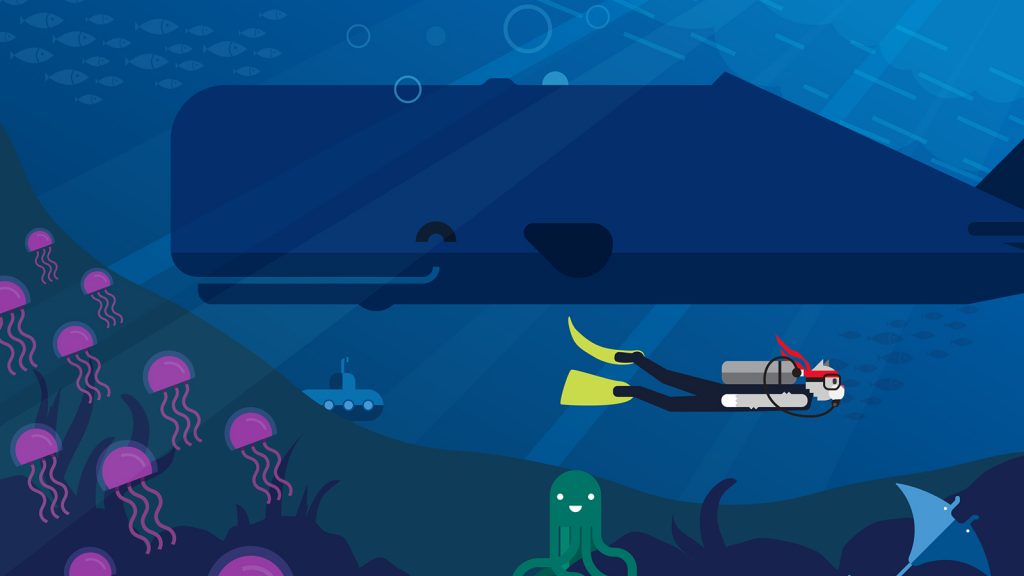
“But impact should always include fun. I get passionate and interested in stuff, and I like nerding out on things,” Lemson said. “My adult ADHD kicks in [Lemson was recently diagnosed] and I’m like, ‘Oooh, how does that work? And what about that thing over there, would that work too?’ Seeing maybe two disconnected things and being able to connect them, it’s just really fun.”
Lemson also has an uncanny ability to be in the know about everything, according to her longtime coworker and friend, Evan Goldring.
“KC is one of those people that gets you excited about coming to work,” he said. “She will fill all the time before meetings and hallway conversations with incredibly relevant, timely, and interesting conversation—either related to current work challenges or incredibly hilarious techie or pop culture stuff. And you’re left wondering how you hadn’t heard those things yet or how the heck KC knows about stuff so fast.
“It’s like she can listen to everyone’s conversations happening in parallel,” Goldring said.
Learning to love herself: the ‘bull in a china shop’ who ‘surfs on chaos’
Always in hot pursuit of that next fun thing, Lemson needs constant change and gets bored easily. And it’s taken her some painful soul searching to accept these qualities as strengths.
Quite a few years back, Lemson had a review that gutted her. “KC surfs on chaos,” one coworker wrote. She realized how right that description was—how she processes out loud and loves to juggle a lot of things at once.
“Some people give birth to this well-planned thought when they speak,” Lemson said, “but me—I just let it fly.” That hasn’t always gone over well.
“It took me a while as a manager to realize that I was frustrating some of my coworkers because of this way of expressing,” Lemson said, pausing thoughtfully. “It’s funny, you can take any statement and look at it from two sides. Ten years ago, I would have taken that feedback and thought, ‘I don’t fit here; what’s wrong with me?'”
But Lemson soon realized that instead of beating herself up for who she was, she would try to explain herself better. “I realized I need to tell people, ‘hey—I don’t need you do this. I am just thinking out loud right now,'” she said.
While surfing on chaos is a cool skill, Lemson knows it’s decidedly uncool for her to expect others to do the same.
She’s also constantly told she’s too aggressive and loud. But she doesn’t worry about criticism that is about the natural qualities of who she is. “I am aggressive and loud,” the self-labeled “staunch feminist” said, rolling her eyes. “You don’t have to like me. That’s life.”
Only, Lemson is undeniably likable. She’s honed the skill of cracking jokes about her foibles, which seems like a different side of the same coin when it comes to accepting and implementing feedback: keep what makes sense for personal growth, laugh off what feels wrong, and move forward.
While Lemson and many people who know her embrace her bull-in-a-china-shop-who-surfs-on-chaos persona, she can remember when she hated those things about herself. Her defining moment came after a severe struggle with clinical depression at age 19. Lemson called the experience “fundamentally changing” because it taught her that she needed to learn to accept herself, get help for her mental state, and live large. It was time to learn to follow her passion: have real fun, wherever you are.

Microsoft: the home of interesting problems
Boasting something like 40 office moves, Lemson knows when it’s time to do something new. So far, Microsoft has been able to hold her ever-wandering interest.
“We have such interesting problems to work on,” she said. “Changing jobs at Microsoft is like moving to a different house in the same neighborhood. Your grocery stores don’t change, but the layout of your living room does.”
Right now, Lemson’s interesting problem on the Surface team is obsessing about building products with the right balance of software, hardware, and the human. Seeing customers as more than enterprise users or consumers is key.
“It comes down to seeing that we are all humans. There are individual human beings behind everything, including at Microsoft.”
“Technology has the potential to be so cool, but if I don’t want to use it, if it’s not going to change my habits, then I don’t care,” she said. “Technology has to benefit human beings, and this company has the will and the DNA to do that.”
Ten years ago I would have taken that feedback and thought, ‘I don’t fit here; what’s wrong with me?’
“Microsoft is one of the very few companies in the world where you can make that impact,” she said. “I don’t want to work on a thing that five people use. I want to work on a thing that lots of people use. It’s just way more fun and interesting.”
To wrap up my time with Lemson, I had to ask about her favorite meme of all time.
She sat in her chair, quiet. Finally, Lemson said, “I’m stumped. That’s just a really important question. Can I get back to you?”








